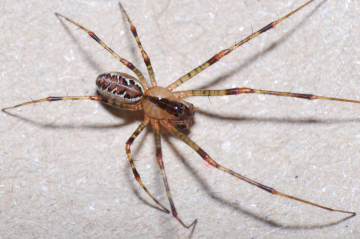Summary for Pityohyphantes phrygianus (Araneae)
previous species | next species
National Distribution
Terms of Use. Double-click on map to go to region

Explore Regional Distribution
Please log on and add a note on this species
About this species
Recorded altitude range3m to 750m
Species text
DistributionThe spider is apparently confined to northern England south to Leicestershire, and southern and central Scotland as far north as Aberdeenshire. It is widespread in Europe, especially in boreal conifer forests, mainly on mountains in southern Europe.
Habitat and ecology
P. phrygianus occurs mainly in plantations of Norway spruce and Sitka spruce, sometimes in association with larch, and on juniper. At one site in Northumberland, it has been found on juniper but not on spruce nearby, and it has been found in well-established native yew in mixed woodland in North Yorkshire and in parkland in Peebles and Midlothian (Baldwin 1990) and Leicester (Daws 2001a). The spider spins a sheet web slung beneath a branch near its tip. It spends the winter on the trees as large immatures. Adults of both sexes have been found in May and June, and females also until August.
Status
The species was first discovered in Britain in 1974. It is possible that it colonised Britain recently, living as it does mainly in spruce plantations. However, it has been found in areas which were previously little-worked, so it could have been present for some considerable time. It has apparently spread widely in recent years and can be abundant at some sites.
Threats
There appear to be no immediate threats to this species.
Management and conservation
When Norway or Sitka Spruce plantations are being felled, ensure that panels are sufficiently small to allow the spider to recolonise replanted areas in the subsequent crop.
Text based on Dawson, I.K., Harvey, P.R., Merrett, P. & Russell-Smith, A.R. (in prep.). References
Adult Season
Habitats
background methodology
Recorded management for locations with Pityohyphantes phrygianus
Recorded substrate and hydrology for locations with Pityohyphantes phrygianus
Images
please log on and upload a new image for this speciesSee also A-Z Species Index - A-Z Picture Index - previous species | next species
